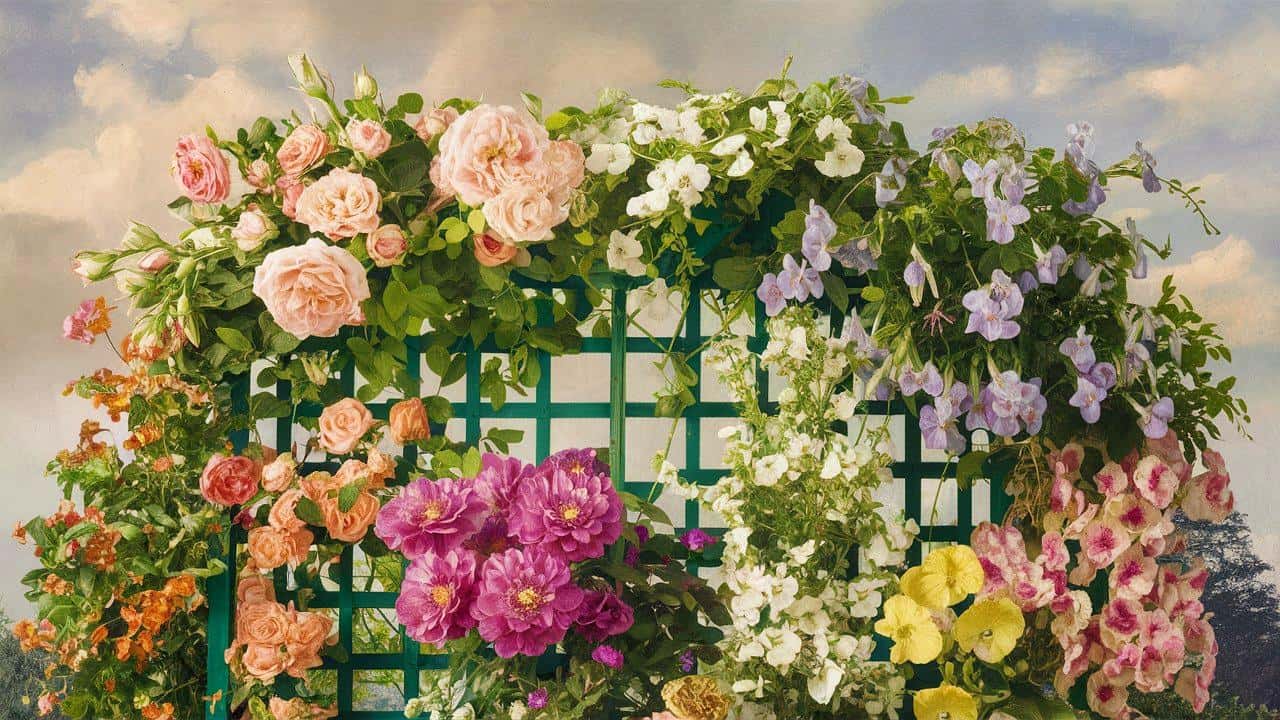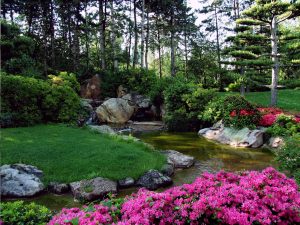Climbing flowers are a captivating addition to any garden, transforming walls, trellises, and arbors into verdant, blooming masterpieces. These versatile plants not only add vertical interest but also bring a touch of enchantment to outdoor spaces. In this comprehensive guide, we’ll explore the best climbing flower varieties that can elevate your garden’s beauty to new heights.
Mandevilla (Mandevilla spp.)

Mandevilla, a tropical beauty from South America, is a versatile and eye-catching climbing plant that can bring a touch of the exotic to any garden. With its showy, funnel-shaped flowers and lush, green foliage, this plant is a true showstopper.
The Mandevilla genus boasts a wide range of cultivars, each offering its own unique charm. From the classic, pure white ‘Alice du Pont’ to the vibrant, pink-hued ‘Sun Parasol,’ there’s a Mandevilla to suit every gardener’s taste. These vines can climb up to 15 feet, making them an excellent choice for covering trellises, arbors, or even spilling over the edges of containers.
Mandevillas thrive in full sun to partial shade and prefer well-drained, nutrient-rich soil. While they are typically grown as annuals in cooler climates, they can be overwintered indoors and replanted in the spring for a stunning encore performance.
Clematis (Clematis spp.)
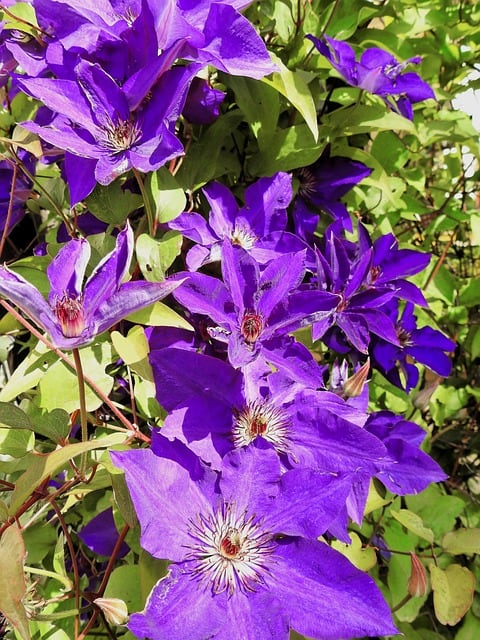
Clematis, often dubbed the “Queen of Climbers,” is a genus of over 300 species that boast an impressive array of flower shapes, sizes, and colors. These vigorous vines thrive in full sun to partial shade and can climb up to 20 feet tall, making them ideal for covering walls, fences, or trellises.
One of the standout features of clematis is the diversity of their blooms. From delicate, star-shaped flowers to large, showy blossoms, the clematis genus offers a wide range of options to suit any gardener’s taste. The vibrant purple ‘Jackmanii’ cultivar, the soft pink ‘Nelly Moser,’ and the striking red ‘Ville de Lyon’ are just a few of the many captivating clematis varieties available.
Clematis vines are relatively easy to grow, requiring well-drained soil and regular watering during the growing season. Pruning is essential to maintain their shape and encourage abundant flowering, with different pruning groups corresponding to the plant’s bloom time.
Trumpet Vine (Campsis radicans)

The trumpet vine, also known as the trumpet creeper, is a bold and eye-catching climbing plant that commands attention in the garden. Native to the eastern United States, this woody vine can reach heights of up to 40 feet, making it an excellent choice for covering large structures or creating a dramatic focal point.
The trumpet vine’s most distinctive feature is its vibrant, trumpet-shaped flowers that bloom in late summer. These fiery-red or orange blooms, arranged in large clusters, attract a variety of hummingbirds and butterflies, adding even more visual interest to the garden.
While the trumpet vine is a fast-growing and hardy plant, it can be quite aggressive and may require regular pruning to keep it in check. It prefers full sun and well-drained soil, and is tolerant of a wide range of growing conditions, making it a versatile choice for many gardeners.
Purple Passionflower (Passiflora incarnata)

The purple passionflower, a native of the southeastern United States, is a truly mesmerizing climbing plant. Its intricate, exotic-looking blooms are a sight to behold, with a crown-like structure and vibrant purple hues that captivate the eye.
Beyond their stunning appearance, the flowers of the purple passionflower hold significant symbolism, with each part of the bloom representing different aspects of the Christian passion. This unique connection has earned the plant the common name “maypop,” referring to the explosive sound the fruit makes when stepped on.
Growing up to 30 feet tall, the purple passionflower is a vigorous and fast-growing vine that can quickly cover trellises, arbors, or fences. It thrives in full sun to partial shade and prefers well-drained, moist soil. While the plant may die back to the ground in colder climates, it reliably returns each spring, making it a reliable perennial choice.
Moonflower (Ipomoea alba)
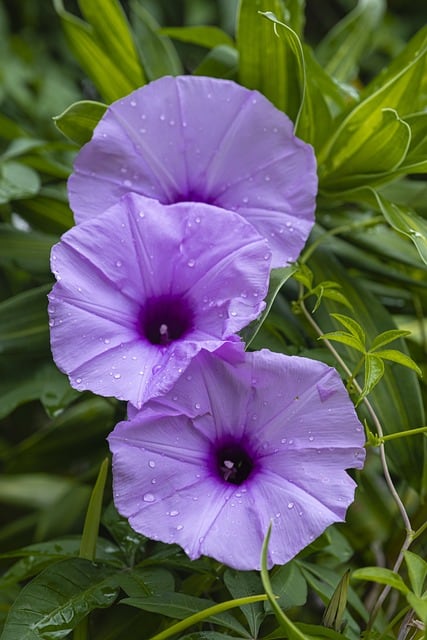
The moonflower, a member of the morning glory family, is a captivating and fragrant climbing plant that truly shines in the evening hours. Native to tropical regions of the Americas, this fast-growing vine can reach heights of up to 20 feet, making it an excellent choice for covering trellises, arbors, or fences.
The moonflower’s most distinctive feature is its large, white, trumpet-shaped flowers that open in the evening and close during the day. These fragrant blooms emit a sweet, intoxicating scent that can fill the air, attracting moths and other nocturnal pollinators. As the flowers fade, they give way to round, spiny seed pods that add further visual interest to the plant.
Moonflowers thrive in full sun and well-drained, moist soil. They are relatively easy to grow and can self-seed readily, making them a low-maintenance choice for gardeners looking to add a touch of enchantment to their outdoor spaces.
Cape Honeysuckle (Tecoma capensis)
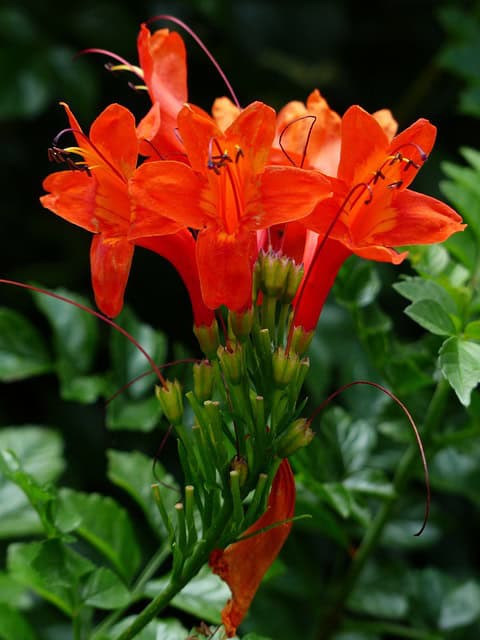
The Cape honeysuckle, a vibrant and tropical-looking climbing plant, is a true showstopper in the garden. Native to South Africa, this evergreen vine can climb up to 20 feet, making it a versatile choice for covering walls, trellises, or even spilling over the edges of raised planters.
The Cape honeysuckle’s most striking feature is its clusters of bright, orange-red tubular flowers that bloom in late spring through fall. These nectar-rich blossoms attract a variety of hummingbirds and butterflies, adding even more visual interest to the garden. As the flowers fade, they give way to long, bean-like seed pods that add further texture and interest to the plant.
In addition to its captivating flowers, the Cape honeysuckle boasts lush, green foliage that remains evergreen in mild climates. It thrives in full sun to partial shade and prefers well-
Japanese Honeysuckle (Lonicera japonica)

The Japanese honeysuckle, a fragrant and fast-growing vine, is a beloved climbing plant that can add a touch of enchantment to any garden. Native to East Asia, this hardy vine can reach heights of up to 30 feet, making it an excellent choice for covering trellises, arbors, or even sprawling over fences.
The Japanese honeysuckle’s most alluring feature is its clusters of tubular, white and yellow flowers that bloom from late spring through summer. These fragrant blossoms emit a sweet, intoxicating scent that can permeate the entire garden, attracting a variety of pollinators, including hummingbirds and butterflies. As the flowers fade, they give way to small, black berries that provide a feast for local wildlife.
While the Japanese honeysuckle is a vigorous grower, it can be considered invasive in some regions, so it’s essential to research local regulations before introducing it to your garden. With proper pruning and containment, however, this plant can be a stunning and low-maintenance addition to any outdoor space.
Climbing Roses (Rosa spp.)

Climbing roses are a classic and beloved addition to any garden, offering a romantic and enchanting vertical element. These vigorous vines can climb up to 20 feet, making them perfect for covering trellises, arbors, or fences.
The diversity of climbing rose varieties is truly remarkable, with a wide range of bloom colors, shapes, and fragrances to choose from. From the delicate, pale pink ‘New Dawn’ to the bold, red ‘Blaze’ and the fragrant, yellow ‘Golden Showers,’ there is a climbing rose to suit every gardener’s taste.
Climbing roses thrive in full sun and well-drained soil, and require regular pruning to maintain their shape and encourage abundant blooms. While they may need some additional support during the growing season, the stunning display of flowers they provide is well worth the effort.
Star Jasmine (Trachelospermum jasminoides)

The star jasmine, also known as the Confederate jasmine, is a captivating and fragrant climbing plant that can transform your garden into a true oasis. Native to Asia, this evergreen vine can climb up to 30 feet, making it a versatile choice for covering walls, trellises, or even trees.
The star jasmine’s most alluring feature is its delicate, star-shaped white flowers that bloom in late spring or early summer. These tiny, fragrant blossoms emit a sweet, intoxicating scent that can permeate the entire garden, attracting pollinators and delighting the senses.
In addition to its stunning flowers, the star jasmine boasts glossy, dark green foliage that remains lush and vibrant throughout the growing season. The plant thrives in full sun to partial shade and prefers well-drained, moist soil, making it a relatively low-maintenance choice for gardeners.
Bougainvillea (Bougainvillea spp.)
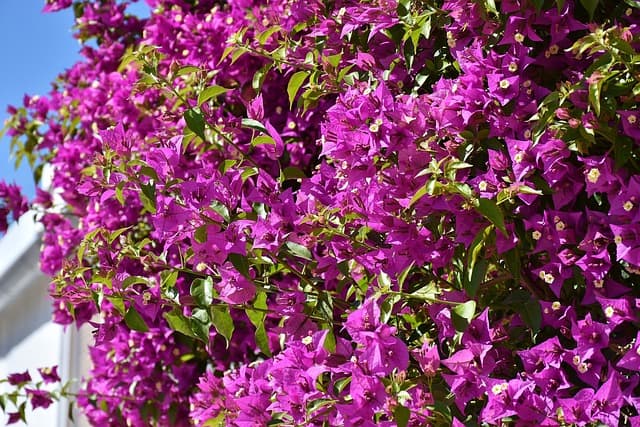
Bougainvillea, a riot of color and texture, is a captivating climbing plant that originates from South America. Known for its vibrant, papery bracts that surround small, inconspicuous flowers, this plant is a true showstopper in the garden.
The Bougainvillea genus offers an impressive array of cultivars, with colors ranging from deep purple and fiery red to soft pink and brilliant orange. These vines can grow up to 30 feet tall, making them an excellent choice for covering walls, trellises, or even spilling over the edges of raised planters.
Bougainvilleas thrive in full sun and well-drained, nutrient-rich soil. They are relatively drought-tolerant and can withstand hot, dry conditions, making them a low-maintenance option for gardeners in warm, Mediterranean-like climates. While they may not be as hardy in colder regions, they can be grown as annuals or overwintered indoors.
Wisteria
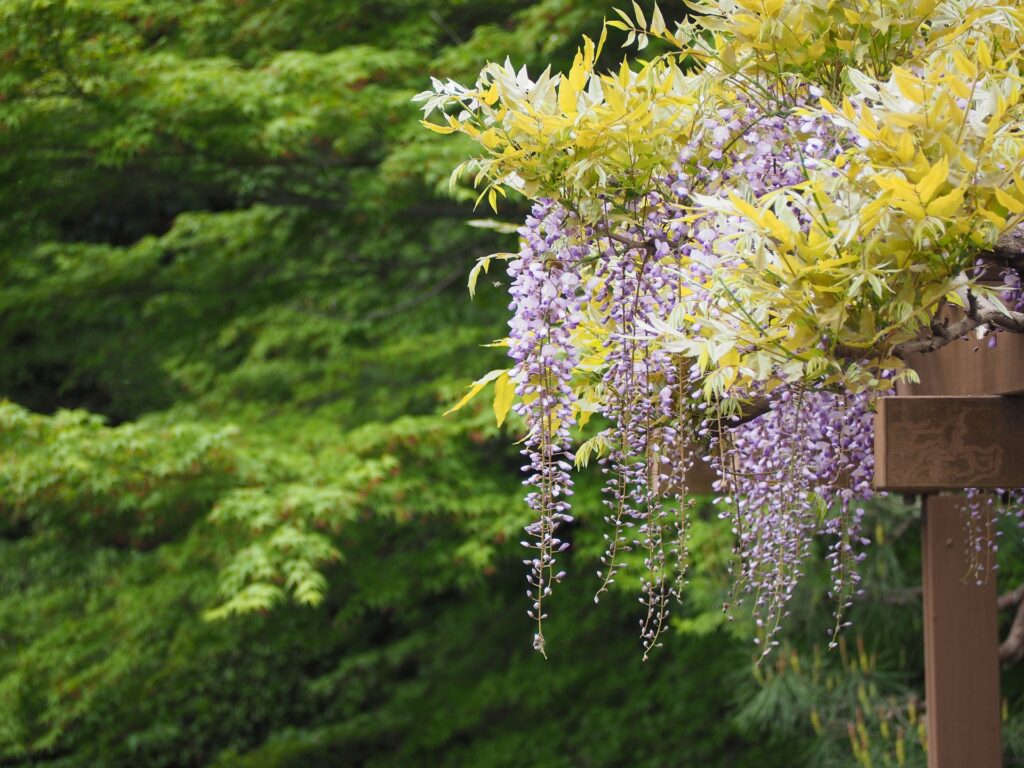
Wisteria is a beloved climbing plant that has captivated gardeners and nature enthusiasts for centuries. With its cascading clusters of fragrant flowers in shades of purple, white, and pink, wisteria is a true showstopper in any garden or landscape.
Native to Asia, wisteria is a woody, deciduous vine that can grow up to 70 feet long, making it an ideal choice for covering arbors, trellises, and pergolas. The plant’s strong, twining stems allow it to climb effortlessly, transforming even the plainest of structures into a breathtaking floral display.
One of the most remarkable features of wisteria is the timing of its bloom. In early to mid-spring, the plant erupts into a stunning display of pendulous flower clusters, often referred to as “wisteria cascades.” These fragrant blooms can reach up to 12 inches in length, creating a mesmerizing, draping effect that seems to defy gravity.
Beyond their visual appeal, wisteria flowers are also highly prized for their intoxicating scent. The sweet, almost vanilla-like fragrance can fill the air, creating a truly enchanting atmosphere in the garden.
When it comes to growing wisteria, patience is key. While the plant can be somewhat slow to establish, with proper care and attention, it will reward you with years of reliable, show-stopping blooms. Wisteria thrives in well-drained, slightly acidic soil and prefers full sun exposure.
Whether you’re looking to add a touch of elegance to a garden arbor or create a stunning focal point in your landscape, wisteria is undoubtedly one of the best climbing flowers to consider. With its stunning appearance and captivating fragrance, this versatile vine is sure to delight gardeners of all skill levels.
Climbing Hydrangea (Hydrangea anomala ssp. Petiolaris)

The climbing hydrangea, a stunning deciduous vine, offers a unique and eye-catching addition to any garden. Native to Asia, this plant can climb up to 50 feet, making it a versatile choice for covering large structures, such as walls, trellises, or even trees.
The climbing hydrangea’s most distinctive feature is its lush, green foliage that transforms into a stunning display of white, lacecap-like flowers in late spring or early summer. These delicate blooms, arranged in large, flat clusters, gradually fade to a soft, creamy hue as they mature. The exfoliating bark of the mature stems adds further visual interest to the plant.
While climbing hydrangeas can be slow to establish, they are worth the wait. They thrive in partial shade to full sun and prefer moist, well-drained soil. Once established, these vines are low-maintenance and can tolerate a range of growing conditions, making them a reliable choice for shaded garden areas.
Chocolate Vine (Akebia quinata)

The chocolate vine, also known as the five-leaf akebia, is a captivating climbing plant that offers both visual and aromatic delights. Native to Asia, this fast-growing vine can reach heights of up to 30 feet, making it an excellent choice for covering trellises, arbors, or fences.
The chocolate vine’s most striking feature is its unique, purplish-brown, sausage-shaped flowers that bloom in early spring. These fragrant blooms emit a sweet, chocolate-like scent that can fill the air, attracting pollinators and delighting the senses. As the flowers fade, they give way to edible, pod-like fruits that resemble small bananas.
In addition to its captivating flowers, the chocolate vine boasts attractive, lobed leaves that emerge in a vibrant, reddish-purple hue, gradually turning green as they mature. This plant thrives in full sun to partial shade and prefers well-drained, moist soil. It’s important to note that the chocolate vine can be considered invasive in some regions, so it’s essential to research local regulations before introducing it to your garden.
Hardy Kiwi Vine (Actinidia arguta or Actinidia kolomikta)
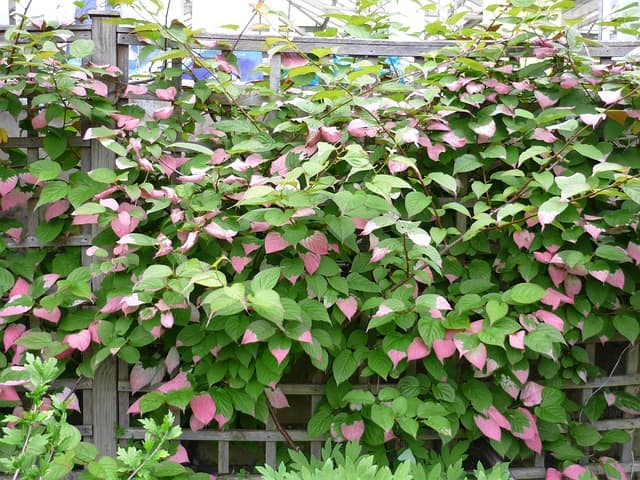
The hardy kiwi vine, also known as the Arctic or Siberian kiwi, is a unique and versatile climbing plant that offers both ornamental and edible benefits. Native to eastern Asia, this vigorous vine can climb up to 40 feet, making it an excellent choice for covering large structures or creating a lush, green canopy.
One of the most striking features of the hardy kiwi vine is its foliage. The leaves emerge in shades of pink, white, and green, creating a stunning display of variegation that persists throughout the growing season. In late spring or early summer, the plant produces clusters of small, fragrant, white flowers that eventually give
Black-Eyed Susan Vine (Thunbergia alata)
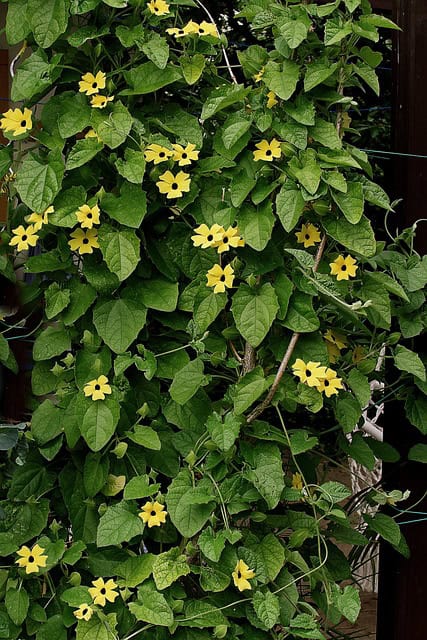
The black-eyed Susan vine, a vibrant and cheerful climbing plant, is a true standout in the garden. Native to tropical regions of Africa, this annual vine can climb up to 8 feet, making it an excellent choice for adding color and vertical interest to containers, trellises, or even spilling over the edges of raised beds.
The black-eyed Susan vine’s most distinctive feature is its daisy-like flowers that bloom in a range of colors, including yellow, orange, white, and even pink. These blooms feature a characteristic dark center that gives the plant its common name. The plant’s lush, green foliage provides a striking contrast to the vibrant flowers, creating a truly eye-catching display.
Black-eyed Susan vines thrive in full sun and well-drained, nutrient-rich soil. They are relatively easy to grow and can tolerate a wide range of growing conditions, making them a popular choice for gardeners of all skill levels. While they may not be as long-lived as some perennial climbers, their prolific blooms and easy care make them a worthwhile addition to any garden.
Cup and Saucer Vine (Cobaea scandens)

The cup and saucer vine, a unique and captivating climbing plant, is a true showstopper in the garden. Native to Mexico and Central America, this fast-growing annual can reach heights of up to 20 feet, making it an excellent choice for covering trellises, arbors, or even spilling over the edges of raised planters.
The cup and saucer vine’s most distinctive feature is its large, bell-shaped flowers that resemble a cup and saucer. These blooms, which can measure up to 4 inches in diameter, start out a vibrant green and gradually transition to a deep, rich purple as they mature. The plant’s lush, green foliage provides a striking contrast to the dramatic flowers, creating a truly mesmerizing display.
Cup and saucer vines thrive in full sun and well-drained, nutrient-rich soil. They are relatively easy to grow, with a fast-growing habit that can quickly cover any desired structure. While they may not be as long-lived as some perennial climbers, their showy flowers and easy care make them a worthwhile addition to any garden.
Bleeding Heart Vine (Clerodendrum thomsoniae)
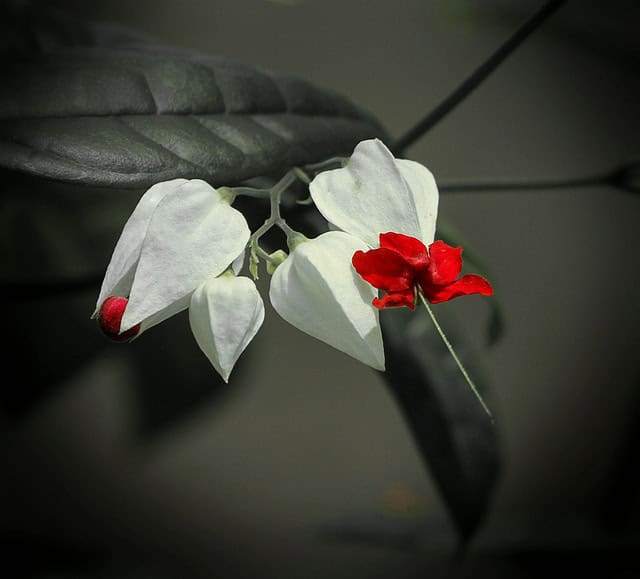
The bleeding heart vine, a tropical beauty from West Africa, is a captivating and unique climbing plant that can add a touch of the exotic to any garden. With its striking, heart-shaped flowers and lush, green foliage, this plant is a true showstopper.
The bleeding heart vine’s most distinctive feature is its clusters of small, white flowers that emerge from bright, fuchsia-colored bracts. These blooms, which resemble tiny hearts, create a dramatic and eye-catching display that can last for several months. As the flowers fade, they give way to small, black berries that provide a feast for local wildlife.
Snail Vine (Cochliasanthus caracalla)
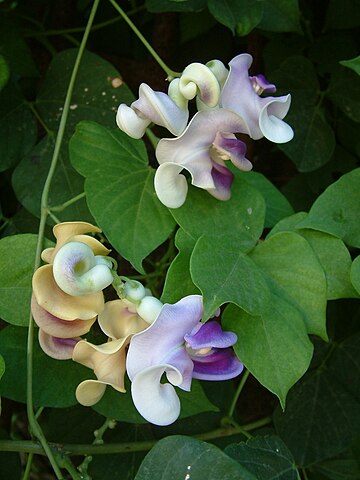
The snail vine, a unique and captivating climbing plant, is a true showstopper in the garden. Native to South America, this fast-growing annual can reach heights of up to 15 feet, making it an excellent choice for covering trellises, arbors, or even spilling over the edges of raised planters.
The snail vine’s most distinctive feature is its clusters of spiral-shaped, fragrant flowers that resemble coiled snail shells. These blooms, which can measure up to 3 inches in diameter, start out a pale yellow and gradually transition to a deep, rich purple as they mature. The plant’s lush, green foliage provides a striking contrast to the dramatic flowers, creating a truly mesmerizing display.
Snail vines thrive in full sun and well-drained, nutrient-rich soil. They are relatively easy to grow, with a fast-growing habit that can quickly cover any desired structure. While they may not be as long-lived as some perennial climbers, their showy flowers and easy care make them a worthwhile addition to any garden.
Sweet Potato Vine (Ipomoea batatas)
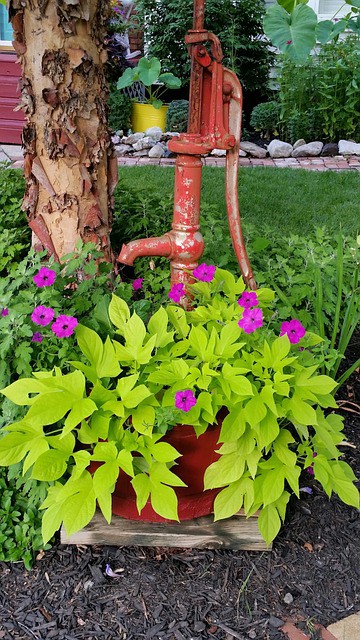
The sweet potato vine, a fast-growing and versatile climbing plant, is a popular choice for adding both vertical interest and vibrant color to any garden. Native to Central and South America, this annual vine can reach heights of up to 10 feet, making it an excellent choice for covering trellises, fences, or even spilling over the edges of containers.
The sweet potato vine’s most distinctive feature is its lush, heart-shaped foliage that comes in a variety of vibrant colors, including deep purple, lime green, and variegated patterns. These eye-catching leaves provide a stunning contrast to the plant’s small, funnel-shaped flowers that bloom in shades of pink, white, or purple.
Sweet potato vines thrive in full sun to partial shade and well-drained, nutrient-rich soil. They are relatively easy to grow and can tolerate a wide range of growing conditions, making them a popular choice for gardeners of all skill levels. While they may not produce the showy blooms of some other climbing flowers, their striking foliage and fast-growing habit make them a valuable addition to any garden.
Corkscrew Vine (Vigna caracalla)
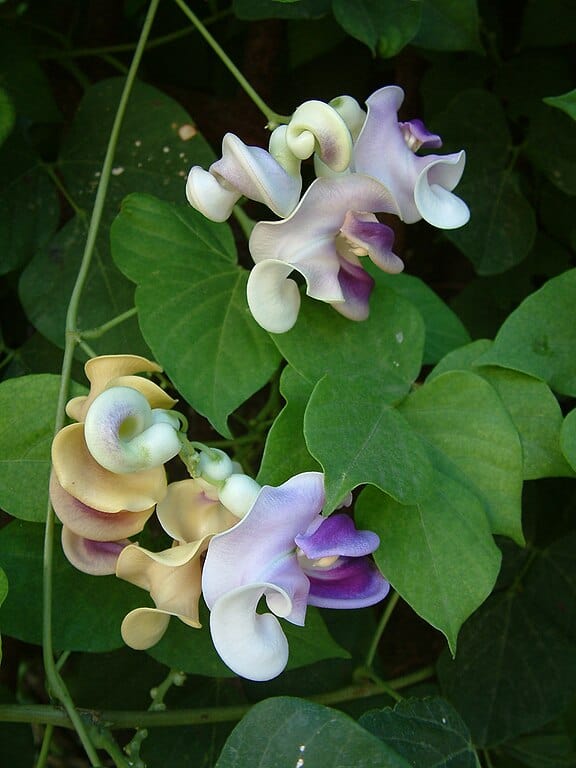
The corkscrew vine, a unique and captivating climbing plant, is a true showstopper in the garden. Native to tropical regions of South America, this annual vine can reach heights of up to 15 feet, making it an excellent choice for covering trellises, arbors, or even spilling over the edges of raised planters.
The corkscrew vine’s most distinctive feature is its clusters of spiral-shaped, fragrant flowers that resemble tightly coiled snails. These blooms, which can measure up to 4 inches in diameter, start out a pale yellow and gradually transition to a deep, rich purple as they mature. The plant’s lush, green foliage provides a striking contrast to the dramatic flowers, creating a truly mesmerizing display.
Corkscrew vines thrive in full sun and well-drained, nutrient-rich soil. They are relatively easy to grow, with a fast-growing habit that can quickly cover any desired structure. While they may not be as long-lived as some perennial climbers, their showy flowers and easy care make them a worthwhile addition to any garden.
Snapdragon Vine (Maurandya scandens)
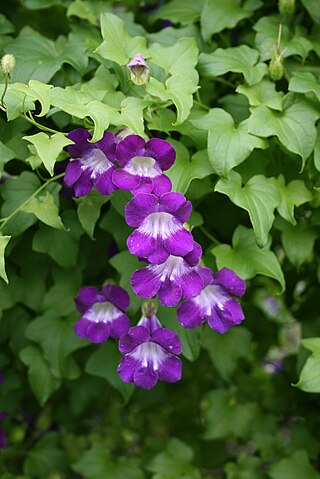
The snapdragon vine, a delicate and charming climbing plant, is a captivating addition to any garden. Native to Mexico and the southwestern United States, this annual vine can reach heights of up to 10 feet, making it an excellent choice for covering trellises, arbors, or even spilling over the edges of containers.
The snapdragon vine’s most distinctive feature is its small, tubular flowers that resemble the iconic blooms of its terrestrial counterpart, the snapdragon. These delicate blossoms, which can come in shades of purple, pink, white, or blue, create a whimsical and enchanting display that can last for several months. The plant’s heart-shaped, green leaves provide a lovely backdrop to the colorful flowers.
Snapdragon vines thrive in full sun to partial shade and well-drained, nutrient-rich soil. They are relatively easy to grow, with a trailing habit that makes them well-suited for hanging baskets or cascading over walls and fences. While they may not be as vigorous as some other climbing flowers, their charming blooms and delicate appearance make them a delightful addition to any garden.
Conclusion
From the vibrant and tropical Mandevilla to the delicate and enchanting snapdragon vine, the world of climbing flowers offers a diverse array of options to elevate your garden’s beauty. Whether you’re looking to cover a trellis, add vertical interest to a container, or create a lush, blooming oasis, these remarkable plants can transform any outdoor space into a true haven.
When selecting the best climbing flowers for your garden, consider factors such as growing conditions, desired height and coverage, and personal aesthetic preferences. With a little bit of planning and care, these captivating vines can become the stars of your garden, providing season after season of stunning displays that will leave your visitors in awe.
So why not explore the endless possibilities of climbing flowers and let them take your garden to new heights? Your outdoor oasis awaits!


